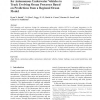Free Online Productivity Tools
i2Speak
i2Symbol
i2OCR
iTex2Img
iWeb2Print
iWeb2Shot
i2Type
iPdf2Split
iPdf2Merge
i2Bopomofo
i2Arabic
i2Style
i2Image
i2PDF
iLatex2Rtf
Sci2ools
133
click to vote
IJRR
2010
2010
Planning and Implementing Trajectories for Autonomous Underwater Vehicles to Track Evolving Ocean Processes Based on Predictions
Path planning and trajectory design for autonomous underwater vehicles (AUVs) is of great importance to the oceanographic research community because automated data collection is becoming more prevalent. Intelligent planning is required to maneuver a vehicle to high-valued locations to perform data collection. In this paper, we present algorithms that determine paths for AUVs to track evolving features of interest in the ocean by considering the output of predictive ocean models. While traversing the computed path, the vehicle provides near-real-time, in situ measurements back to the model, with the intent to increase the skill of future predictions in the local region. The results presented here extend preliminary developments of the path planning portion of an end-to-end autonomous prediction and tasking system for aquatic, mobile sensor networks. This extension is the incorporation of multiple vehicles to track the centroid and the boundary of the extent of a feature of interest. Si...
| Added | 28 Jan 2011 |
| Updated | 28 Jan 2011 |
| Type | Journal |
| Year | 2010 |
| Where | IJRR |
| Authors | Ryan N. Smith, Yi Chao, Peggy Li, David A. Caron, Burton H. Jones, Gaurav S. Sukhatme |
Comments (0)

